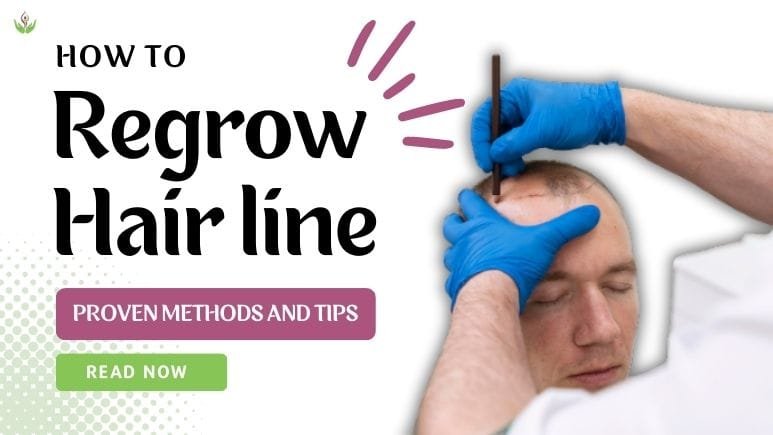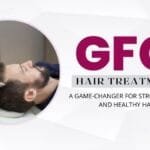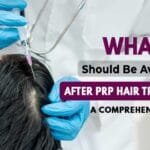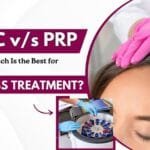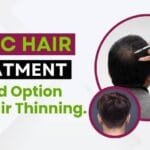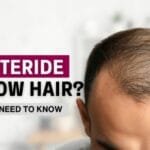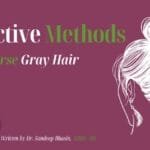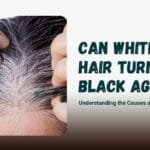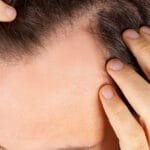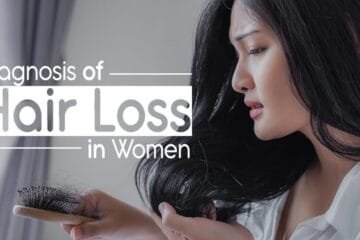Introduction
Are you experiencing a receding hairline and wondering how to regrow it? Many individuals, regardless of gender, face the common issue of hairline recession. However, with the right strategies and lifestyle changes, it’s possible to stimulate hair regrowth and restore your hairline. This article aims to provide you with valuable insights and actionable steps to address hairline recession effectively.
Hair loss is a common condition that affects both men and women, and one of its prominent manifestations is a receding hairline. The hairline gradually starts to thin and recede, causing individuals to feel self-conscious and frustrated. Understanding the underlying causes of hairline recession is crucial to determining the most effective strategies for regrowth.
- Genetics and Hormonal Factors: One of the primary culprits behind a receding hairline is genetics. Androgenetic alopecia, commonly known as male or female pattern baldness, is often responsible for the hairline recession. Hormonal imbalances, such as an excess of dihydrotestosterone (DHT), can also contribute to hair loss.
- Age: As we age, our hair follicles undergo natural wear and tear, leading to hair thinning and receding hairlines. The rate and severity of hairline recession vary from person to person.
- Poor Haircare Practices: Frequent use of harsh hair products, excessive heat styling, and tight hairstyles like ponytails and braids can damage the hair follicles and contribute to hair loss, including a receding hairline.
- Nutritional Deficiencies: Inadequate intake of essential nutrients, such as vitamins, minerals, and proteins, can impact the health of your hair follicles. Malnutrition can weaken hair strands and result in hairline recession.
- Medical Conditions and Treatments: Certain medical conditions like thyroid disorders, autoimmune diseases, and scalp infections can cause hair loss and a receding hairline. Additionally, treatments like chemotherapy can result in temporary hair loss.
Understanding the Hair Growth Cycle
Hair growth follows a cycle that consists of three stages:
- Anagen phase: This is the active growth phase that can last for several years. During this phase, hair follicles are actively producing new hair, and the hair shafts are firmly rooted in the scalp.
- Catagen phase: This is the transitional phase that lasts for a few weeks. During this phase, the hair follicles shrink, and the hair shafts become detached from the scalp.
- Telogen phase: This is the resting phase that lasts for several months. During this phase, the hair follicles are inactive, and the hair shafts remain detached from the scalp until they are shed naturally.
- Factors affecting the hair growth cycle: Genetics, hormonal changes, stress, age, diet, and specific medications can all have an impact on the hair growth cycle. These factors can disrupt the hair growth cycle, leading to hair thinning, shedding, and receding hairlines. Understanding the hair growth cycle and the factors that can affect it can help in finding effective solutions for regrowing the hairline.
Steps to Regrow Your Hairline
- Consult a Dermatologist: If you’re concerned about your receding hairline, the first step is to consult a dermatologist or hair specialist. They can evaluate your condition, identify the underlying cause, and recommend appropriate treatment options.
- Opt for Medications: In cases where hair loss is due to hormonal factors, your doctor may prescribe medications like minoxidil or finasteride. These medications can help slow down hair loss and promote regrowth, including the restoration of your hairline.
- Consider Surgical Treatments: For individuals seeking more advanced and permanent solutions, surgical treatments like hair transplants can be an effective option. A hair transplant involves harvesting hair follicles from donor areas and transplanting them to the receding hairline.
- Adopt a Healthy Lifestyle: A healthy lifestyle plays a crucial role in hair regrowth. Ensure you have a balanced diet rich in vitamins, minerals, and proteins. Regular exercise, stress management techniques, and sufficient sleep also contribute to overall hair health.
Medical Approaches for Regrowing Hairline
There are several medical approaches that can be used to regrow a receding hairline:
- Medications:
- Minoxidil (Rogaine): Minoxidil is a topical medication available over the counter. It stimulates hair growth by increasing blood flow to the hair follicles, promoting thicker and fuller hair. It is typically applied directly to the scalp twice a day.
- Finasteride (Propecia): Finasteride is an oral medication that requires a prescription. It works by blocking the conversion of testosterone into dihydrotestosterone (DHT), a hormone that contributes to hair loss. Finasteride helps to slow down hair loss and promote hair regrowth, particularly in the crown area.
- Prescription-strength topical treatments: A dermatologist might advise some prescription-strength topical treatments, such as topical corticosteroids or retinoids, to encourage hair regrowth in the hairline area. These treatments can help reduce inflammation, promote hair follicle health, and encourage hair growth.
- Platelet-rich plasma (PRP) therapy: PRP therapy involves the injection of platelet-rich plasma derived from the patient’s own blood into the scalp. Platelets contain growth factors that can stimulate hair follicles and promote hair regrowth. PRP therapy is a non-surgical procedure that may be recommended for individuals with thinning hair or a receding hairline.
- Hair transplant surgery: Hair transplant surgery is a surgical option for regrowing a receding hairline. It involves taking hair follicles from areas of the scalp with healthy hair growth (typically the back or sides of the head) and transplanting them to the areas experiencing hair loss, including the hairline. This procedure can provide long-lasting and natural-looking results.
It is important to consult with a medical professional, such as a dermatologist or a hair restoration specialist, to determine the most suitable medical approach based on individual circumstances and goals.
Healthy Lifestyle Habits for Hair Regrowth
- Balanced Diet: Incorporate the best diet plan for stopping hair fall foods like leafy greens, fruits, lean proteins, and nuts into your diet. These provide essential nutrients like vitamin E, biotin, and omega-3 fatty acids, which promote hair health and regrowth.
- Hydration: Drink an adequate amount of water daily to keep your body and hair hydrated. Hydration is vital for maintaining scalp health and promoting hair regrowth.
- Avoid Smoking and Excessive Alcohol Consumption: Smoking and excessive alcohol intake can hinder proper blood circulation to the scalp, negatively impacting hair growth. Quitting smoking and moderating alcohol consumption can support hair regrowth efforts.
- Stress Management: Chronic stress can contribute to hair loss. Engage in stress-reducing activities like meditation, yoga, or hobbies to promote a healthy hair growth environment.
Nutritional Support for Hairline Regrowth
- Vitamin Supplements: Consider incorporating supplements like biotin, vitamin D, and vitamin E into your daily routine after consulting with your healthcare professional. These vitamins support hair health and can aid in hairline regrowth.
- Essential Minerals: Minerals like zinc, iron, and selenium are vital for hair growth. Ensure your diet includes foods rich in these minerals or consult with a healthcare professional for appropriate supplementation.
- Protein-Rich Foods: Increase your intake of protein-rich foods like lean meats, fish, eggs, and legumes. Proteins provide the building blocks for hair growth and help strengthen hair follicles.
Natural Remedies and Treatments for Hairline Regrowth
- Scalp Massage: Gently massaging your scalp stimulates blood circulation, which promotes hair growth. Use natural oils like coconut or castor oil during the massage to nourish the scalp.
- Aloe Vera: Aloe vera gel has soothing properties and can help maintain scalp health. Apply fresh aloe vera gel directly to the scalp and leave it on for 30 minutes before rinsing.
- Onion Juice: Onion juice contains sulfur compounds that may stimulate hair regrowth. Apply onion juice to your scalp, leave it on for 15–30 minutes, and rinse thoroughly.
- Green Tea Rinse: Green tea is rich in antioxidants that can promote hair growth. Brew green tea, let it cool, and use it as a final rinse after shampooing your hair.
Advanced Treatments for Hairline Restoration
- Hair Transplant: A hair transplant is a surgical procedure where hair follicles are extracted from donor areas and transplanted into the receding hairline. It offers a permanent solution for hairline restoration, yielding natural-looking results.
- Platelet-Rich Plasma (PRP) Therapy: PRP therapy involves extracting platelets from your blood and injecting them into the scalp. Platelets contain growth factors that can stimulate hair growth and improve the density of the hairline.
- Low-Level Laser Therapy (LLLT): LLLT uses red light wavelengths to stimulate hair follicles and promote regrowth. It is a non-invasive treatment that can be done at home or at specialized clinics.
Hair Care Tips to Prevent Further Hairline Recession
- Avoid Overstyling: Limit the use of heat styling tools and avoid tight hairstyles that pull on the hairline, as they can cause damage and further hair loss.
- Use Gentle Hair Products: Opt for gentle, sulfate-free shampoos and conditioners that nourish and protect the hair. Avoid harsh chemicals that can strip away natural oils and damage the hair.
- Protect Your Scalp: Shield your scalp from excessive sun exposure by wearing hats or using sunscreen specifically formulated for the scalp.
Psychological Impact of Hair Loss and Coping Strategies
- Seek Support: Share your feelings with loved ones or join support groups where you can connect with others experiencing similar challenges.
- Professional Counseling: Consider seeking professional counseling to address any emotional distress associated with hair loss and develop coping mechanisms.
- Explore different hairstyles: haircuts, or hairpieces that can help conceal hair loss and boost confidence.
Seeking Professional Advice
When dealing with hairline regrowth, seeking professional advice can be highly beneficial. Consider the following options:
- Consulting with a dermatologist or trichologist: Dermatologists and trichologists specialize in diagnosing and treating conditions related to the hair and scalp. They can assess the specific causes of your receding hairline and provide expert guidance on suitable treatments. These professionals can perform thorough examinations, evaluate medical histories, and recommend appropriate solutions.
- Customized treatment plans: Professionals can create personalized treatment plans tailored to your specific needs and circumstances. They will consider factors such as the underlying cause of hairline receding, overall health, lifestyle, and preferences. Customized plans may include a combination of medical interventions, lifestyle adjustments, and hair care recommendations.
- Professional hair care recommendations: Dermatologists and trichologists can provide valuable advice on how to care for your hair to promote regrowth and maintain a healthy hairline. They may recommend specific shampoos, conditioners, and styling products that are suitable for your hair type and concerns. Additionally, they can provide guidance on proper hair care techniques, such as brushing, washing, and drying, to minimize damage and support hair health.
Seeking professional advice ensures that you receive accurate information, appropriate diagnoses, and effective treatment options. Professionals can offer expertise, monitor your progress, and make adjustments as needed, increasing your chances of regrowing your hairline successfully.
Lifestyle Changes for Overall Hair Health
Making certain lifestyle changes can contribute to overall hair health and potentially aid in regrowing a hairline. Consider the following:
- Maintaining a healthy lifestyle: Adopting a healthy lifestyle positively impacts hair health. This includes eating a balanced diet rich in vitamins, minerals, and proteins that support hair growth. Additionally, staying hydrated and managing stress levels can contribute to a healthier scalp and hair.
- Regular exercise and adequate sleep: Regular physical activity improves blood circulation, including to the scalp, which can support hair follicle health. Engaging in exercise also helps reduce stress, which can be a contributing factor to hair loss. Furthermore, ensuring an adequate amount of sleep allows the body to regenerate and promote healthy hair growth.
- Avoiding smoking and excessive alcohol consumption: Smoking restricts blood flow to the hair follicles and can contribute to hair loss. Excessive alcohol consumption can deplete vital nutrients necessary for healthy hair growth. Quitting smoking and moderating alcohol intake can improve hair health and promote regrowth.
- Hygiene practices for scalp health: Maintaining proper hygiene practices for the scalp is essential for hair health. Regularly washing the hair and scalp with a mild shampoo removes dirt, excess oil, and product buildup that can clog hair follicles and impede hair growth. It is important to avoid harsh shampoos and excessive washing, as they can strip the scalp of natural oils and cause dryness.
Incorporating these lifestyle changes can support overall hair health and potentially aid in regrowing a receding hairline. It is important to note that individual results may vary, and it is recommended to consult with a healthcare professional for personalized advice and guidance.
Conclusion
Regrowing a receding hairline is possible with the right approach and lifestyle changes. By understanding the causes of hairline recession and implementing strategies like healthy habits, natural remedies, and advanced treatments, you can stimulate hair regrowth and restore your hairline. Remember to consult with healthcare professionals or specialists to determine the most suitable options for your specific situation.
Incorporate a balanced diet, nutritional supplements, and natural remedies like scalp massage, aloe vera, onion juice, and green tea rinses into your hair care routine. Consider advanced treatments such as hair transplants, PRP therapy, and low-level laser therapy for more significant results. Additionally, practice proper hair care habits, protect your scalp from damaging factors, and address the psychological impact of hair loss through support and self-care.
While regrowing your hairline takes time and patience, embracing self-acceptance and focusing on your overall well-being can help you navigate the journey with confidence. Remember, you are more than your hair, and taking care of yourself holistically is key.
References:
- Journal of the American Academy of Dermatology: https://www.jaad.org/
- International Journal of Trichology: https://www.ijtrichology.com/
- Journal of Investigative Dermatology: https://www.jidonline.org/
- Dermatologic Surgery: https://journals.lww.com/dermatologicsurgery/pages/default.aspx

